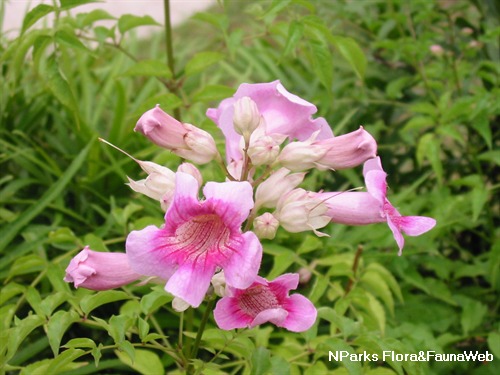
Back
Podranea ricasoliana (Tanfani) Sprague
| Family Name: | Bignoniaceae |
| Common Name: | Pink Trumpet Vine, Port St Johns Creeper, 非洲凌霄 |
Podranea ricasoliana, also known as Pink Trumpet Vine is a vigourous evergreen climber with fragrant, pink trumpet flowers and glossy dark green leaves. This plant is an excellent addition to pergolas and arbors or planted against the fence for screening.
Name
Classifications and Characteristics
| Plant Division | Angiosperms (Flowering Seed Plants) (Dicotyledon) |
|---|---|
| Plant Growth Form | Climber, Shrub |
| Lifespan (in Singapore) | Perennial |
| Mode of Nutrition | Autotrophic |
| Plant Shape | Shrubby |
Biogeography
| Native Distribution | South Africa |
|---|---|
| Native Habitat | Terrestrial |
| Preferred Climate Zone | Tropical |
| Local Conservation Status | Non-native (Horticultural / Cultivated Only) |
Description and Ethnobotany
| Growth Form | Woody climber with a rambling growth form. Stems are often 3-5 m long, but can grow to more than 10 m long. |
|---|---|
| Foliage | Compound leaves are odd-pinnate with glossy, green leaflets. Each leaf is composed of about 4 pairs of elliptic leaflets and 1 terminal leaflet. The leaflets are hairless with a wavy margin. |
| Flowers | Fragrant, pink to light purple flowers are trumpet-shaped and 2-lipped. The upper lip is divided into 2 round lobes, while the lower lip is made up of 3 round lobes. The throat is whitish, covered in white hairs and striped with dark purple lines. They are arranged in a spike-like inflorescence known as a raceme located at the branch tips. |
| Fruit | Dry dehiscent fruit is known as a capsule. It has a long, narrow shape which is flattened and contains brown, egg-shaped seeds which are winged. |
| Cultivation | This low maintenance plant is fast-growing. It grows best in well-drained, nutrient rich soil with regular applications of compost. Pruning is required to encourage flowering. It has no tendrils, therefore it needs to be tied to supports. |
| Etymology | The genus Podranea is an anagram of Pandorea which means pandora. |
Landscaping Features
| Landscaping | Excellent plant for pergolas, arbors or trellises, however plant needs to be tied up to the support. Plant can also be planted against the fence or wall as espalier or to create screening effect. |
|---|---|
| Desirable Plant Features | Ornamental Flowers |
| Landscape Uses | Parks & Gardens, Small Gardens, Hedge / Screening, Trellis / Arbour / Pergola |
Fauna, Pollination and Dispersal
| Fauna Pollination Dispersal Associated Fauna | Bee-Attracting |
|---|---|
| Pollination Method(s) | Biotic (Fauna) |
| Seed or Spore Dispersal | Abiotic |
Plant Care and Propagation
| Light Preference | Full Sun |
|---|---|
| Water Preference | Moderate Water |
| Plant Growth Rate | Fast |
| Rootzone Tolerance | Moist Soils, Well-Drained Soils |
| Propagation Method | Seed, Stem Cutting (Semi-Hardwood, Hardwood) |
Foliar
| Foliage Retention | Evergreen |
|---|---|
| Mature Foliage Colour(s) | Green |
| Mature Foliage Texture(s) | Glossy / Shiny |
| Prominent Young Flush Colour(s) | Green |
| Young Flush Texture(s) | Glossy / Shiny |
| Foliar Type | Compound (Odd-Pinnate) |
| Foliar Arrangement Along Stem | Opposite |
| Foliar Attachment to Stem | Petiolate |
| Foliar Shape(s) | Non-Palm Foliage (Elliptical) |
| Foliar Venation | Pinnate / Net |
| Foliar Margin | Entire, Entire - Wavy / Undulate |
| Foliar Apex - Tip | Acuminate |
| Foliar Base | Acute |
Floral (Angiosperm)
| Flower & Plant Sexuality | Bisexual Flowers |
| Flower Colour(s) | Pink, Red, White |
|---|---|
| Flower Texture(s) | Smooth |
| Flower Grouping | Cluster / Inflorescence |
| Flower Location | Terminal |
| Flower Symmetry | Bilateral |
| Individual Flower Shape | Trumpet-shaped, Labiate / Lipped |
| Inflorescence Type | Raceme |
| Flowering Period | Free-Flowering |
Fruit, Seed and Spore
| Mature Fruit Colour(s) | Brown |
|---|---|
| Fruit Classification | Simple Fruit |
| Fruit Type | Dehiscent Dry Fruit , Capsule |
| Mature Seed Colour(s) | Brown |
Image Repository
Others
| Master ID | 197 |
|---|---|
| Species ID | 1493 |
| Flora Disclaimer | The information in this website has been compiled from reliable sources, such as reference works on medicinal plants. It is not a substitute for medical advice or treatment and NParks does not purport to provide any medical advice. Readers should always consult his/her physician before using or consuming a plant for medicinal purposes. |

.jpg)
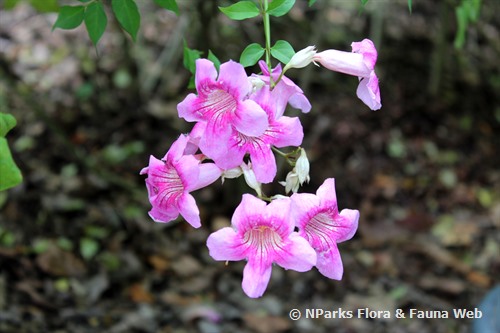
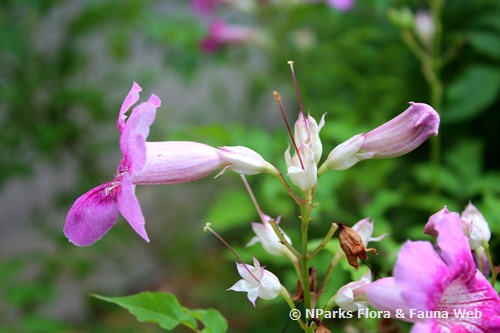
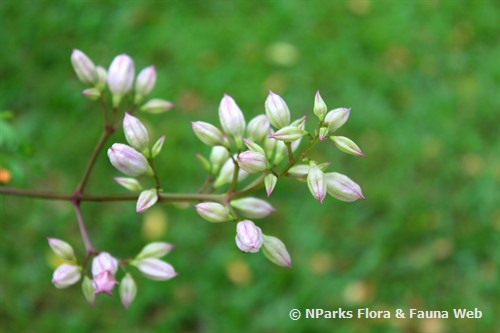
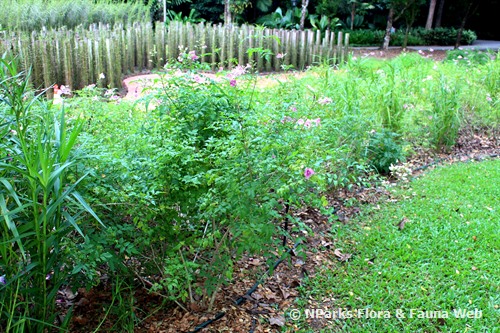
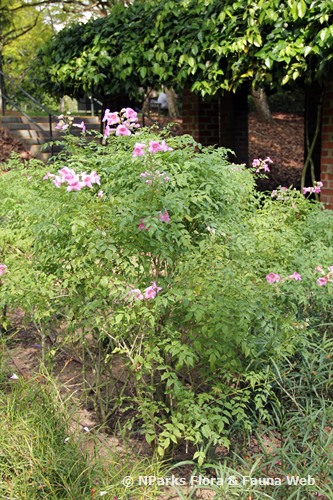
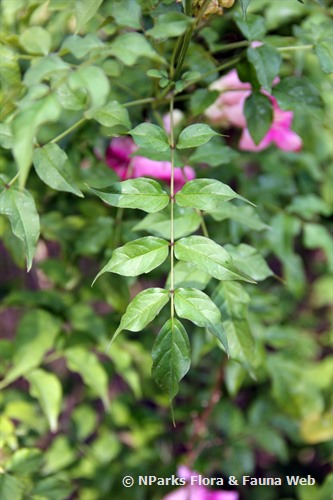
.jpg)